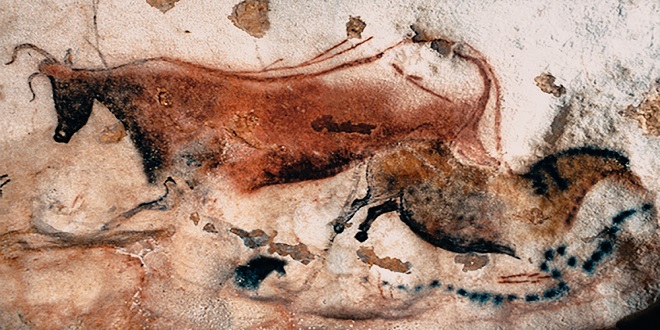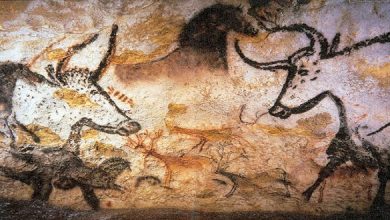Rock Art of the Drakensberg vs the Cave Paintings of Lascaux

The Zulu call it uKhahlamba: “Barrier of Spears.” Dutch settlers, encountering its formidable reptilian spine in the 1830s, named it the Drakensberg, or “Dragon’s Mountain.” By either name, the jagged series of peaks over 11,000 ft (3,400 m) rising within uKhahlamba-Drakensberg Park – Africa’s largest tract of protected mountain wilderness – is an immense and imposing sight, besides which the replica caves at Lascaux cannot help but seem contrived in comparison.
Below these wild craggy peaks stands a giant open-air gallery of prehistoric rock art – a full 500 individual painted shelters and caves, remarkable both for the fine quality of their workmanship and for their excellent state of preservation.
Among the sites that stand out for quality and accessibility is Game Pass Shelter, which features a beautifully executed main frieze of a herd of elands (Africa’s largest antelope) interspersed with various human figures. Dubbed the “Rosetta Stone” of the uKhahlamba-Drakensberg, it was here that the scholar David Lewis-Williams “cracked the code” of religious symbolism that underlies the area’s rock art, revealing it to depict figures in a state of shamanic trance, and hunters absorbing the qualities of the animals they killed.
At Giant’s Castle, the prosaically named Main Cave hosts 500 human and animal figures, ranging from the ubiquitous eland to big cats and snakes. Here, a life-size replica of the so-called “bushmen” serves to introduce the artists responsible for this ancient tradition. While the oldest paintings in the Drakensberg may be 3,000 years old, the most recent are only about 150 – they depict the first oxwagons to roll across the escarpment, carrying the European settlers who took possession of the land, shooting the local “bushmen” population on sight.
THE BUILD-UP
Dubbed the “Sistine Chapel of Prehistory,” Lascaux is the most famous of 25 painted caves in France’s Vézère Valley, containing around 1,800 individual figures – horses, stags, bulls, and other animals – whose rich color and lifelike detail belie their antiquity, estimated at 15–35,000 years old.
THE LETDOWN
Opened to the public in 1948, Lascaux had to close 15 years later when it was noted that changes to the subterranean microclimate associated with human traffic and artificial lighting would soon destroy the paintings. The original cave has never reopened to the public, and the replica “fauxLascaux” a short walk away can feel touristy.
GOING ANYWAY?
Touristy it may be, but faux-Lascaux is devoutly faithful to the original. The two finest galleries – the Chamber of Bulls and Central Corridor – have been reproduced down to the last contour and brushstroke using identical natural pigments such as ochre, charcoal, and iron oxide.
PRACTICAL INFORMATION
Getting There and Around
Fly to Johannesburg or Durban. From the airport, rent a car, set up a customized tour, or catch the inexpensive Baz Bus (www. bazbus.com) to one of the backpacker hostels that organize hiking trips from the foothills.
Where to Eat
All hotels, backpacker hostels, and resorts serve adequate to good meals, mostly at very reasonable prices. To splash out, head to the award-winning Cleopatra Mountain Farmhouse
Where to Stay
The Orion Mont-Aux-Sources (www.oriongroup.co.za) is the most scenic hotel, but Cathedral Peak beats it for rock art access. For good value, try one of the national park’s rest camps.
Last word
UKhahlamba-Drakensberg ranks among the elite group of 26 UNESCO World Heritage Sites to be inscribed on both cultural and natural grounds. Boasting spectacular scenery and abundant wildlife, its wild beauty is a world away from the landscaped walkways of Lascaux. You can ramble through lush green foothills, brave a hike up to the escarpment, or snake your way by jeep up the sole pass that breaches the Barrier of Spears’ otherwise impregnable border with Lesotho.
Far from being stage-managed, the Drakensberg still hosts a profusion of the elands so beloved of the bushmen, while quarrelsome baboons bark shrilly from the cliffs, vying to be heard above the calls of 300 species of birds.




